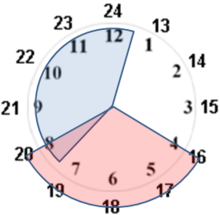Garbharakshambigai temple
| Thirukkarugavoor / Thirukkarukavur | |
|---|---|
|
| |
 Thirukkarugavoor / Thirukkarukavur Location in Tamil Nadu | |
| Name | |
| Other names | Karukaatha Amman, Garbarakshagi, |
| Proper name | Garbarakshambigai Temple |
| Geography | |
| Coordinates | 10°52′5″N 79°16′32″E / 10.86806°N 79.27556°ECoordinates: 10°52′5″N 79°16′32″E / 10.86806°N 79.27556°E |
| Country | India |
| State | Tamil Nadu |
| District | Tanjore |
| Location | Papanasam |
| Culture | |
| Primary deity |
Mullaivananathar (Shiva) |
| Consort |
Garbharakshambigai (Parvathi) |
| Direction and posture | East |
| Temple tank | Ksheera Kundam (Milk Pond) |
| Poets | Thirunavukkarasar, Thirugnanasambandhar |
| Important festivals | Vaikasi Visagam, Navarathiri |
| Architecture | |
| Architectural styles | Dravidian architecture |
| Inscriptions | 31 |
| History and governance | |
| Date built | 6th century |
| Website | http://garbaratchambigaitemple.org/ |
Garbharakshambigai Temple is a Hindu temple dedicated to Lord Shiva located in Thirukarukavoor, Tamil Nadu, India.[1] The temple is located 6 km east of Papanasam, 20 km south east of Kumbakonam, 10 km north of Saliyamangalam, 20 km north east of Thanjavur and on the southern bank of Vettar river.[2] The place is also called Tirukalavur, Mullaivanam, Mathavipuram and Garabapuri. Since Mathavi is the temple tree, it is called Mathavipuram (Mullaivanam); Karu means womb, Ka means save and oor means village - Since womb is believed to be saved by the temple deity, the village is called Tirukarukavoor.[2]
The temple
Thirukarukavoor Temple is dedicated to Shiva and is located near Papanasam, Tanjore, Tamil Nadu, India. The temple has a 5-tier Rajagopuram and an outer prakaram(closed precincts of a temple). There are inscriptions from Cholas and king Koparakesarivarman. The temple is 460 ft by 284 ft and has a gopuram facing east and also has an entrance facing south.[2] There is a garden in the southern side and a Vasantha Mandapam in the north.[2] The sanctum of Mullaivananathar is in the second precinct and the shrine of Amman is located parallel to the Swami shrine. The shrine is Nandi is located in front of Swami, with the Palipeeda and Dwajasthambam located right behind the Nandi.[2] There is a Nataraja hall and a yagasalai. There are separate shrines for Natarajar, Somaskanda, Karpaga Vinayagar and Navagrahas.[2] There are separate shrines for Sezhkizhar, Nalvar, Santhanachariar, Dakshinamoorthy, Nrithivu Nayakkar, Arthanariswarar, Mahalakshmi, Arumugan, Brahma, Durga and Chandikeswarar.[2] There are four water bodies associated with the temple. Sheerakundam (Parkulam) is the temple tank located opposite to the temple and the water is believed to be born out of the milk of Kamadenu, the sacred cow.[3] Sathyakupam is a well located in between the shrines of Swami and Amman. Brahma Theertham is a tank located north east of the temple - Nataraja gives theerthavari during Karthigai Thivatharai in this tank.[3] Vritha Kaveri is the branch of Kaveri, Vettaru (also called Mullivay) - the stepshore is the bank for many of the temple occasions.[3] The temple tree, Mullai tree is located in between the Swami shrine and Chandikeswarar shrine.[3]
Literary Work
The temple finds mention in Tevaram, the 7th century 12 volume Saiva canonical work by Tamil saints, namely Appar, Sundarar and Campantar.[4] The temple also finds mention in Periya Puranam by Sezhkizhar, Siva Ksehtra Sivanamaga Kalivenba by Umapathi Sivam and Vinnapakali Venba by Ramalinga Adigal.[4] Thalapuranam by Ambalavana Pandaram, Nanmaimalai & Rettaimanimalai by Veerabathra swamigal, Pathirru Panthathi by Govindaswami Pillai, Vadamozhi Slogangal by Anatharama Dikshithar and Amman thothirangal Tamilpattu by T.S. Vaithiyanathan are some of the religious works associated with the temple.[4]
Festivals
vaikasi Visagam for Swami, Adipooram and Navarathri uthsavam for Ambal, Annabishekam, Kanthasashti, Karthigai Mahadeepam, Karthigai Sunday theerthavari and Panguni Uthram are some of the prominent festivals celebrated.[5]
Inscriptions
The temple has 31 inscriptions dating from the Chola period from the reigns of Koperi Varman, Raja Raja I, Rajendra Chola I and Kulothunga Chola.[5] The inscriptions record the grants of the temple by the kings. The inscriptions are found on the walls of the temple, sanctum and also in the halls. The inscriptions are recorded in numbers 100, 102 and 110 in South Indian Inscriptions, Volume III, Part III.[5]
Poojas/Sevas
- Blessed Ghee for pregnancy
- Blessed castor oil for easy delivery
- Punugu sattam
- Abishegam
- Annadhanam
- Kattalai Archanai
- Navakodi Ghee lamps
- Sandana Kaapu
- Thanga Thottil : 7AM - 12:30PM; 4PM-8PM
- Thulabharam
- Earboring and Tonsure prayers
Temple Timings
7:00AM – 12:30PM
4:00PM – 8:00PM

Transport
The nearest railway station is in Papanasam, about 3 kilometres from the place. The nearest airport is in Trichy. Thirukarukavoor is situated in Thanjavur - Kumbakonam main road. People from Chennai and northern parts of Tamil Nadu may reach Kumbakonam and from there to Thirukarukavoor. People from east and southern parts of Tamil Nadu must reach Thanjavur and from there to Thirukarukavoor. The temple is one of the prominent and most visited temples in the district.[6]
Accommodation
There are no Lodges at this location, but paid bathrooms are available inside the temple campus for a nominal charges to freshen up.
Gallery
-
The temple tank
-
Depiction of the legend
-
The Garbharakshambigai shrine
-
Lord Dakshinamoorthy
-
Gopuram view from Temple tank
-
Gopuram of the temple
-
Sunrise view in temple tank
-
The temple tank
-
Main Entrance of the Temple
Notes
References
- Sundararajan, K.R.; Bithika Mukerji (2003), Hindu spirituality: Postclassical and modern, USA: Cross Road Publishing Company, ISBN 81-208-1937-3
- Pillai, M. Sivaguru (2000). Mullaivananathar Tirukoil Varalaru (6th ed.). Thirukoil Veliyeedu.
External links
- Official Website of Sri Garbarakshambigai Temple
- A Private Blog about Sri Karparatchaambigai Temple
- Photos about Sri Karparatchaambigai Temple


